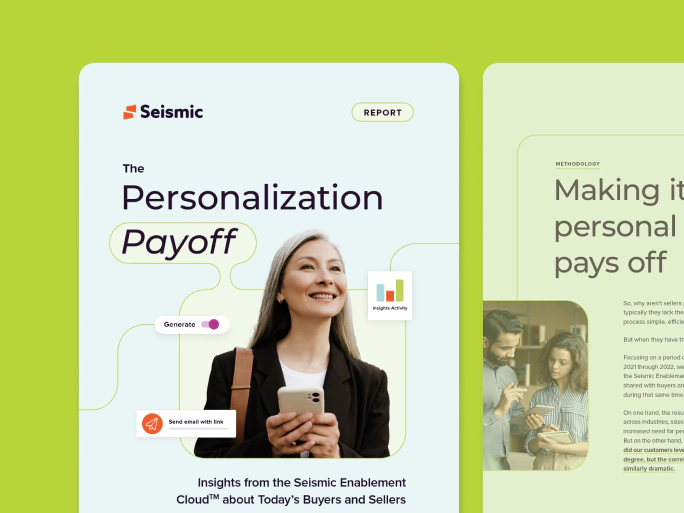Today’s buyers are savvier and more informed than ever. With most sales decisions occurring online, the buyer journey takes place across multiple digital channels, includes many stakeholders, and has more interactions than ever before. A study from Forrester found that the average buyer engages in 27 info-gathering sessions — whether that’s visiting your website, checking social media accounts, or reading product reviews—before they even reach out to a seller.
When a buyer eventually reaches out to a seller— every interaction counts. Sellers need to streamline and simplify the sales process while providing helpful and personalized content. This is when a digital sales room can be extremely useful.
What is a digital sales room?
A digital sales room, or DSR, is a secure and centralized location where sales reps and buyers can collaborate and access content that is relevant to the deal cycle. Digital sales rooms are organized and engaging microsites where sellers can create differentiated stories and personalized interactions that support buyers throughout their decision-making process.
Digital sales room software streamlines the buyer experience by providing easy access to content, stakeholders, and communications. This drives more effective buyer engagement and gives sellers the ability to stand out from the competition.
Sellers can use digital sales rooms to share deal-specific content with buyers. The software can also be used to continue conversations and collaborate with stakeholders as they navigate the sales process. Most importantly, digital sales room software gives buyers a single location and source of truth that they can return to throughout the deal cycle.
Did you know?
On average, buyers have 27 information-gathering sessions before they interact with a salesperson.
How does a DSR work?
Digital sales rooms simplify the sales process for buyers and sellers alike. At a time when buyers are engaging everywhere, it’s important for buyers and sellers to have a dedicated environment for meaningful conversation and content experiences. Let’s take a closer look at some of the common features and functionality of digital sales room tools.
Personalization: Digital sales room software allows sellers to customize templates and personalize content for each specific buyer. Drag and drop tools allow sellers to quickly and easily update digital sales rooms with the right content and organize it in a way that’s intuitive for buyers to locate and navigate.
Communication and collaboration: Buyers and sellers can engage with each other throughout the deal cycle through 1:1 conversations, tagging, and commenting capabilities. This also drives better visibility to the most important and helpful content to keep communication flowing between buyers and stakeholders.
Track and analyze: DSRs help sellers better understand which content resonates with buyers. By accessing real-time engagement insights, sellers can identify which stakeholders have consumed content. This helps them identify follow-up opportunities that can move deals forward faster.
Personalization Matters

Why use a digital sales room?
Buyer behavior is quickly evolving, and traditional in-person selling is no longer the norm. According to McKinsey, 70% of decision-makers are open to fully self-serve or remote purchases more than $50,000, and 27% would spend more than $500,000.
Buying teams are not only making remote purchases — they’re also researching products digitally. Before a buyer first interacts with a salesperson, in most cases, they’ve already had 27 information-gathering interactions. Therefore, sellers need to make the most of their interactions with buyers early in the sales process. They do this by creating personalized, differentiated experiences for buyers.
Digital sales rooms are effective because they align with the way buyers interact throughout the sales cycle. According to Gartner predictions, 30% of B2B sales cycles will be managed through digital sales rooms by 2026. Because buyers increasingly want a seller-free experience, it’s important for sellers to create a virtual selling experience that allows buyers to drive their own journey.
Digital sales rooms create a dedicated environment for buyers to find the content they need when they need it, while still having the option to interact with a seller if they have additional questions. DSRs are also particularly effective because they align with and support the common buyer behavior known as looping. This is when buyers visit the same channel several times throughout the sales cycle. Digital sales rooms simplify this scattered experience by creating a dedicated environment for buyers to find the content they need, when they need it.
Accelerate the sales cycle.
What are best practices for using digital sales rooms?
If sellers want to thrive in digital sales, there are a few best practices and tips to keep in mind.
1
Be prepared to answer tough questions
2
Leverage the right content
3
Always be available
What to look for in digital sales room software
Selecting the best digital sales room software is a strategic decision that can significantly impact sales performance and organizational success. As your organization considers the pros and cons of digital sales room tools, keep these capabilities in mind.
User-friendly interface: Select a tool that features an intuitive design that makes it easy for sellers and buyers to use and navigate with little to no training.
Content analytics: A data-driven tool ensures that your go-to-market teams understand what resonates with buyers. Key metrics from digital sales room software can help improve best practices over time.
Collaboration tools: Deal cycles are a two-way street with communication among sellers and buyers. Digital sales room software should facilitate easy communication, document sharing, and real-time collaboration.
Security and compliance: Prioritize software with encryption, access controls, and compliance certifications to safeguard sensitive data. For example, the best digital sales room software provides sellers and advisors in highly regulated industries to ensure that the content they share is always consistent and compliant.
If your organization is interested in a solution with all the above, Seismic Digital Sales Rooms might be just what you need.
Drive more engagement with Seismic’s digital sales room tool
As the global leader in sales enablement, the Seismic Enablement Cloud™ is purpose-built to support sales organizations across the entire sales journey. Seismic’s digital sales room software aims to help GTM teams develop buyer-seller relationships from one centralized platform. Seismic’s Digital Sales Rooms enable collaboration between sales teams and their buyers to deliver relevant, unique, and personalized content to streamline the virtual sales process.
GTM teams can also track and manage progression of sales deals, conversations, content, and insights all within a single virtual location. Teams that leverage digital selling experience improved buyer engagement, too. We found that companies across a variety of industries increased buyer engagement by an average of 197% with Seismic’s Digital Sales Rooms. Interested in learning more? Click here to see a digital sales room in action. Or get a demo to learn more.
Don’t just take our word for it
See why Seismic has earned a 4.7 out of 5-star rating from customers on G2.
Seismic has been a game-changer for us! It’s allowed us to put content in the hands of our client-serving Associates faster and more efficiently – and all in one spot!
Seismic has provided an excellent platform for consolidating our content and the ability to easily share this content with our client base when compared to other similar solutions.
I like that Seismic can become the single source of truth for sales, sales enablement and marketing and the analytics are second to none.
My favorite part of Seismic is that it’s my best friend out in the sales field. I use it to answer every question I have about my work and the products we offer.
Seismic allowed our company to fully have a one-stop-shop for all Marketing, Sales, Business Development, and Partner Success content.
The most helpful thing about Seismic is having all of your content and resources in one easy-to-locate area.



